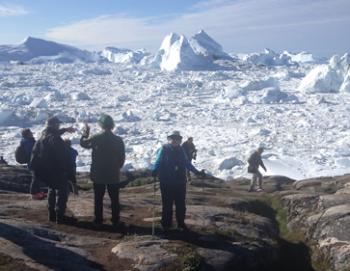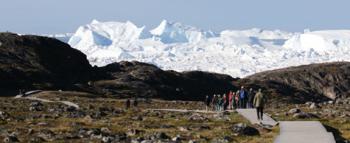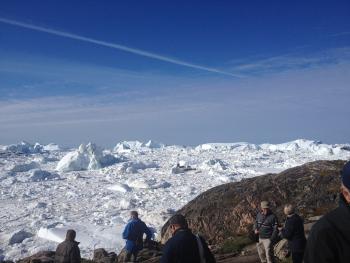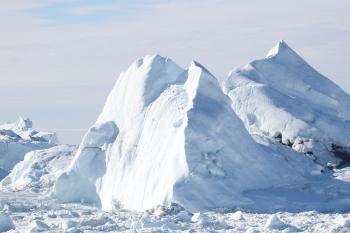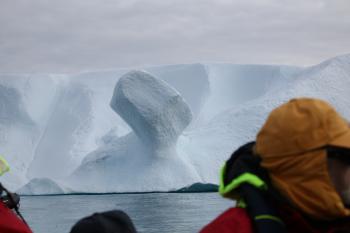Ilulissat Icefjord & Greenland
This item appears on page 26 of the October 2019 issue.
My wife and I had a wonderful experience on the “Route of the Vikings” cruise with Seabourn Cruise Line (800/442-4488, www.seabourn.com). We started in Reykjavik, Iceland, on Aug. 6, 2018, and ended in Montréal, Québec, on Aug. 30.
Carrying up to 450 passengers, the luxury MV Seabourn Quest is a smallish ship. The cost for the two of us was about $35,000, which included six stops in Greenland and time in the Canadian Arctic, including in Newfoundland & Labrador. Unlike on many cruises, the fare included free alcoholic drinks.
We certainly enjoyed our comfort as well as an excellent expedition crew, who were experts on birds, whales and the historic voyages of the Vikings.
Greenland was the highlight for me and an eye-opener. Our stops ranged from the capital, Nuuk (pop. 18,000), to tiny Paamiut (pop. 1,800), but nothing could compare to the Ilulissat Icefjord, a UNESCO World Heritage Site. I’ve been to more than 100 countries and have seen many sights, but this was by far the most awe-inspiring and beautiful of all. It, alone, was worth the whole trip.
The fjord is about 55 kilometers (34 miles) long and is fed by a glacier directly off the Greenland icecap. The glacier moves at the lightning speed (for a glacier) of slightly more than 100 feet per day, shedding 35 cubic kilometers of ice per year into the fjord and then into Disko Bay, where Ilulissat is located.
Some of the chunks of ice breaking off the glacier are nearly a kilometer thick. Some of the biggest ones get stuck on the bottom, and the ice coming in from behind then piles up into incredible tangles until enough pressure is exerted to move them along. Eventually, everything floats off as icebergs, some of which are the size of mountains.
There are different ways to see the ice. We walked the 1.5-kilometer-long boardwalk from the edge of town to a viewpoint overlooking the fjord near the mouth. The view was breathtaking. We saw a huge jumble of ice with some gigantic peaks.
We later took a Zodiac tour provided by the ship around the mouth of the fjord, amid floating and grounded icebergs that had taken on all sorts of spectacular shapes. Local tour operators also run flights over the fjord.
Ilulissat has more of a tourist infrastructure than other places we visited in Greenland, with several modern-looking hotels and restaurants.
Unless you’re on a cruise, Ilulissat would not be an easy place to get to. You can fly to Greenland from Denmark or Iceland and then take a local flight, but the flights are subject to delay or cancellation because of fog. Ferries travel up and down the coast from Nuuk but not frequently.
After seeing the Ilulissat Icefjord, everyplace else seemed to me like an anticlimax when it came to natural views, but everywhere we stopped in Greenland was interesting in one way or another. The towns were attractive and the people, friendly.
The old part of Nuuk contains the fabulous Greenland National Museum & Archives (en.nka.gl), where one can spend several hours, as well as lovely, old, brightly painted houses and a small beach (yes, really!). While we were there, a few people were sunbathing in the 16°C (60°F) temperature, with a small iceberg floating a few yards from the shore.
The new part of town, higher up, was very modern, with a large hotel, shopping mall, several other shops and a few restaurants.
Outside Nuuk, there was usually at least one decent but basic hotel, and even in the smallest places, a couple of restaurants (often Thai!).
Of Greenland’s population, 88% of the people are native Inuit, and the remainder are European (mostly Danish), but there were certainly a few Asians running the Chinese and Thai restaurants.
Greenlandic is by far the most commonly spoken language, but Danish is also an official language. Almost everybody we encountered also spoke very good or passable English.
One thing that surprised us everywhere we stopped was the number of vehicles. Many people seemed to drive around in cars, in spite of the fact that they couldn’t go more than 5 to 10 kilometers in any direction before the road ended. There were also buses and taxis everywhere.
Another interesting feature of towns in Greenland is that many residents own dogsleds that they use in the winter. We visited two areas on the outskirts of towns where sled dogs were kept (from dozens to hundreds).
They’re all kept in the open, each with a small kennel for shelter. Each dog was on a chain that prevented it from encroaching on the next dog’s territory, although puppies are allowed to run free. They’re all huskies.
During our six days in Greenland, the climate was mostly sunny or partly cloudy during the day, but it was usually foggy in the early morning and out at sea. Maximum temperatures varied from 12°C to 16°C (54°-60°F).
I had always imagined Greenland as a giant ice cap, having flown over it many times, but everywhere we went was green, with the houses all brightly painted and vibrant communities. We certainly will never forget the people, the scenery and the whole experience. We highly recommend Greenland to travelers looking for something different.
DAVID SELLEY
Toronto, ON, Canada

